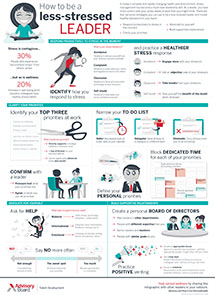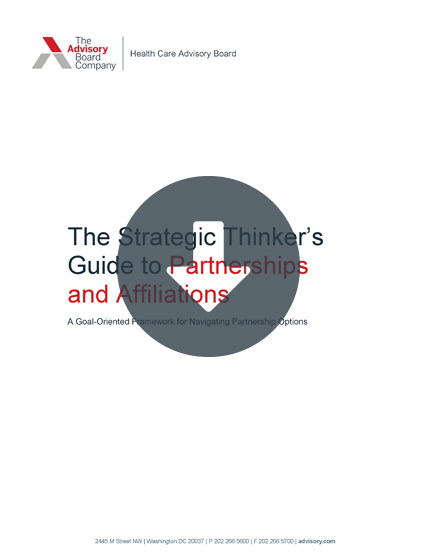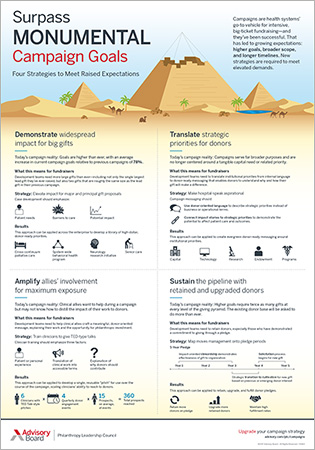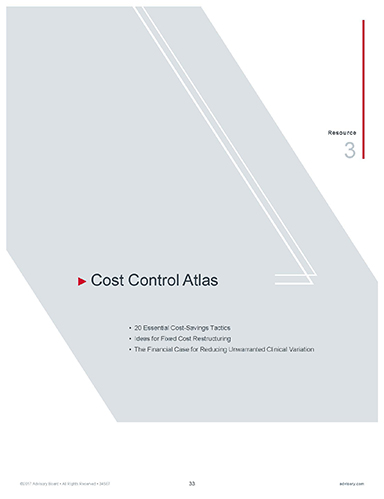Welcome to the "Lessons from the C-suite" series, featuring Managing Partner Eric Larsen's conversations with the most influential leaders in health care.
In this edition, Kelby Krabbenhoft, president and CEO of Sanford Health, talks about the unprecedented CEO-philanthropist partnership behind Sanford's rapid growth, why a successful leader needs to be "a little bit of a pirate," and the merger that will make Sanford a nearly $6 billion health system.
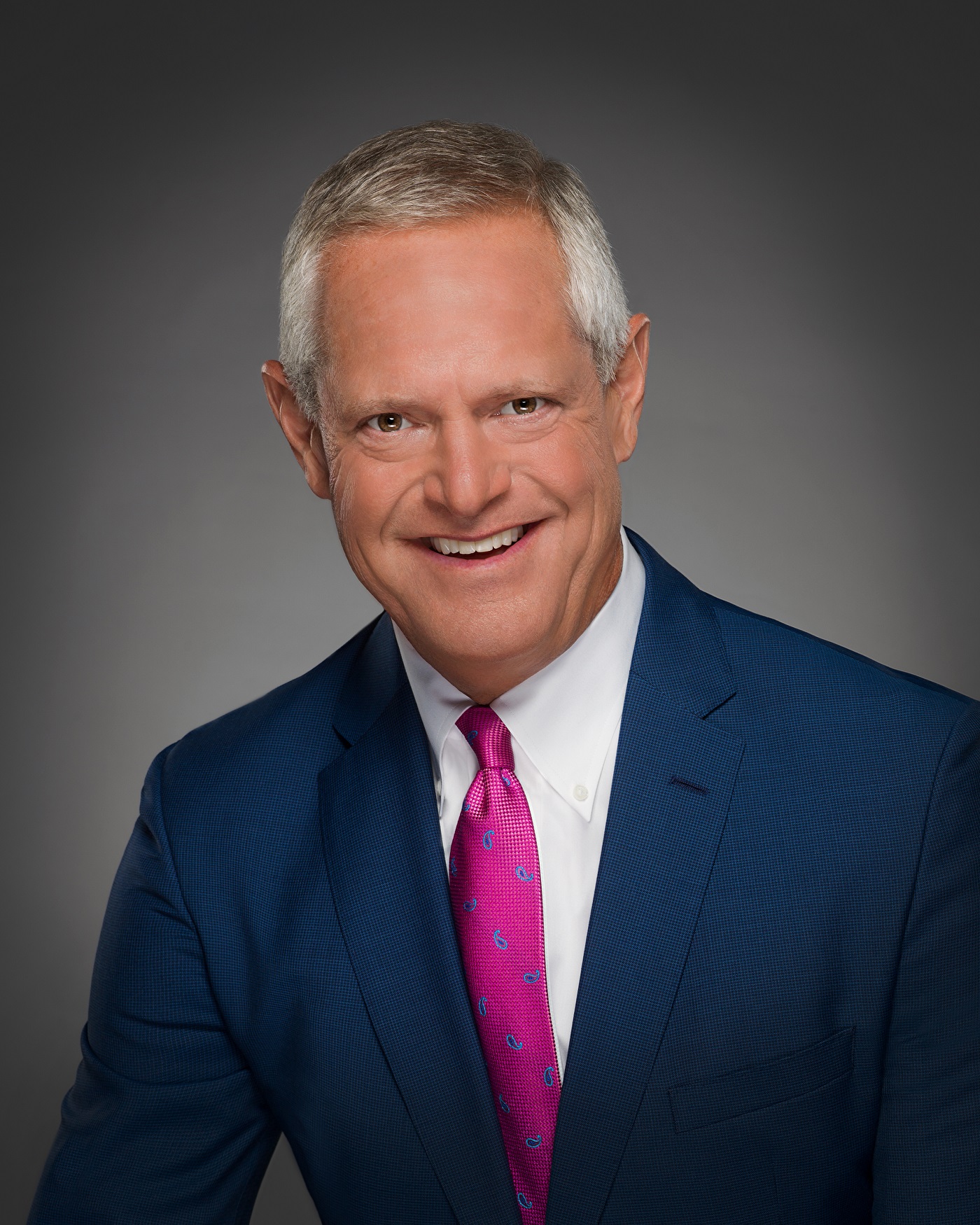
Kelby Krabbenhoft, president and CEO of Sanford Health
The down-home values—and 'pirate' attitude—that shaped a leader
Question: Kelby, before we dive into the challenges of leading a $6 billion, multi-state (and now multinational) health system, I'd like to start smaller. Let's talk about the one-doctor town of Guttenberg, Iowa, where you launched your health care career as president of the local hospital—and pitched in on everything from turning on the furnace to delivering babies. What stands out to you about that experience?
Kelby Krabbenhoft: I've always thought that you should leave something that you have better than when you found it. And when I arrived in Guttenberg, there was one doctor who exemplified that: Dr. Mike Downey. He's since passed, but he remains a role model for sacrifice and dedication, delivering probably every single person in that community over the course of his 60-year career there. I still keep his picture in my office.
So he was the town's one doctor, but by the time I left, two years later, there were four or five.
Q: A better way to say that is that you quintupled the number of doctors.
Krabbenhoft: There you go. Exaggeration is a great tool.
But yeah, I'll never forget those humble beginnings. When the maintenance guy couldn't get in, I was the one shoveling the sidewalk.
Q: And you were the president of the hospital.
Krabbenhoft: Right. And our surgeon at the time covered four hospitals, so—when there was a car accident or some young man put his foot in an auger during harvest—I'd get to scrub in, even though I'm not a doctor. In fact, my most enjoyable memory from that time was being able to close C-sections. To this day, I'd rather hang in the operating room than in my office. And in fact, I think that experience is what influenced me to make one specific small change at Sanford—every single time a baby is born and in the hands of its mother, we play Brahms' Lullaby. So you hear it every day, all the time. It makes you pause in whatever you're doing and realize that a new life has started at Sanford.
But the point is that I've been driven by these early lessons: use common sense, and don't get too big for yourself. And in the Sioux Falls and North Dakota region, where I ended up, we try to exemplify that down-home sensibility.
Q: Is it fair to say, then, that you ascribe your success to these down-home values?
Krabbenhoft: Well, there's another part of me that's a little bit of a pirate, a little anti-authority—in more fashionable terms, a little disruptive. My passion is to try to change things for the better. And I'm lucky, because the board I work with shares that feeling.
And it's worked pretty well. The typical tenure of a CEO in a health system like this is about four years, and I'm coming into my 23rd year. And then I announced that I'm going to retire in four years, and when you declare the end of your career runway, it forces you to think about all you want to accomplish in the time left.
Sanford has a growth plan—but don't call it 'aggressive'
Q: Am I reaching a little too much if I say there is an interesting juxtaposition between these Midwestern sensibilities—don't get too big for yourself, etc.—and Sanford being, arguably, one of the most aggressively expansionary systems in the United States?
Krabbenhoft: It's interesting, because that term—"aggressive"— has dogged me for decades. When I see the guy in the mirror, I don't see that. Maybe I look aggressive?
Q: You're 6'6". You can't avoid it.
Krabbenhoft: I'd put it this way: Our team has a mindset about what's necessary to survive and to succeed, and scale is one way to achieve that. But it's not an end in itself. We aren't attempting to walk in a room and throw down, you know?
Q: That's funny, because for me, "aggressive" is a neutral term. What word would you choose to describe your strategy, then?
Krabbenhoft: "Megapolitan." We've talked about that before, right?
A few years ago, Jeff Immelt at G.E. was talking about his view of the health care industry, and he projected that, within 20 years, there would only be 25 big health systems in the United States. And we were surprised when we saw his map, because it didn't include some of the traditional health system giants in Minneapolis or other places. But right up there in the Great Plains it included Sanford.
Re-ignite the growth engine: 3-part report series
Then at the same time, by sheer coincidence, a study came out of the University of Utah making a similar case—and they called it the "Megapolitan America." It simply says there are anchor metropolitan economic regions, like Minneapolis in our region, that increasingly will dominate commerce over huge stretches of the country.
And when my team looked at that theory, it just made sense to think about our cause within that framework.
Q: When you say "your cause," you're referring to addressing the cost of health care across an entire economic region?
Krabbenhoft: Right. We see regional competitive bidding as an emerging solution to high costs.
Now, this isn't new; there have been attempts or successes in every state. I use Jim Hinton at Presbyterian as an example a lot: he's been managing the Medicaid business in New Mexico for a long time. That shows providers are capable of taking risk, of getting the premium upfront, and then managing a population very successfully.
Q: And you're planning to replicate that approach in other regions?
Krabbenhoft: Yes, and we think we're well-positioned to succeed. We already manage the population of North Dakota's retirement system and their employees—68,000 lives—so we're demonstrating that we can work with government to resolve their health care issues. And that includes caring for plenty of retirees who leave North Dakota, because this population, being retirees, are tired of winds and winter and they head south.
More broadly, we believe there are things that insurance companies owned by health systems can do very, very well—like creating economies of scale in back room services, and billing, and claims processing—and we've been doing that for a long time.
Sanford as a health insurer
Q: Let's talk more about Sanford's experience as a health insurer. Other health systems have had a lot of misadventures taking first dollar risk and trying to organize provider-sponsored health plans, but you've been remarkably successful—I believe you have more than 190,000 covered lives. What lessons have you learned along the way?
Krabbenhoft: Well, we certainly weren't a success from day one. I'm going to say this briefly and then move on, but: I learned a lot when we tried—and failed—to get an insurance business off the ground in Joplin, Missouri, in the 1990s. The problem wasn't the doctors; it was that employers weren't ready for dynamic discussions around managing care.
And I learned a real good lesson: To succeed in the health plan business, it isn't enough to run the gauntlet of actuarial science and set the right premium. You have to meet employers where they are.
Q: How did that insight shape your approach toward building an insurance company when you went to Sioux Falls—a company that now, based on all relevant metrics, is prospering?
Krabbenhoft: For one thing, we started in Sioux Falls by covering our own employees. I mean, how lucky can you be? A new adventure, but you get to keep it all home.
Q: That certainly helps. So if you were doing it again today, is that how you'd start again—with your own employees?
Krabbenhoft: No. When we did it, it was a little bit of the frontier. You had a horse and a gun, you could go, right? But now it's a different deal; success and experience already exist, and the risk and the requirement that you make a big impact fairly quickly is gone, too.
You can't come in and just insure your employees for a few years, and then go to the commercial market for a few years, and then try to expand into some government work for a few years—there's just not time for that. That evolution opportunity is gone.
Q: But you would still go forward with a provider-sponsored health plan?
Krabbenhoft: You have to do that, right? The traditional insurer does not have the infrastructure to manage care as intimately as we can. It's not perfect or automatic, but we can manage risk to a price point at an immediate and intimate degree that a traditional insurer can't reach.
So I'd do it, but I'd just go about it differently—I would sit down with someone like me or Andrea Walsh or the people at Kaiser and say, "Is there a place for our system in your system? And in what construct can we come together?"
Q: I'm sympathetic to that view, but the recent history as you and I would agree hasn’t been easy going. In the last two years, there have been more than a dozen joint ventures—white-labeled health plan partnerships—between established managed care companies and providers, or between provider-owned health plans and other systems. Many of these ventures have struggled.
Krabbenhoft: Yes, I agree, Eric. And I’ll go even further. This joint venture business doesn't work—you're not in the same locker room; you haven't swapped blood. You've got to merge; you've got to be one company, marching at the same direction at the same time with the same passion. And you've got to yield to your partner—who is now you, okay? You yield to the bigger thing.
The problem with a joint venture is that you show up saying, "Let's go solve this problem," and they're like, "OK, I'll help you, but what's in it for me?" That's a joint venture. That doesn't work—which isn't to say I don't understand it. I think most of the time, CEOs who sign onto joint ventures are just trying to protect what we call the "north 40."
Q: The north 40?
Krabbenhoft: That's acreage in farm talk, as in, "That north 40 acres has been in our family for 150 years, and by God, the Johnsons aren't ever going to buy it." We call it the "north 40" or the "north 40 complex," but the idea is the same: You'll never sell your north 40. You might do a lot of other things, but you're not going to sell it.
Merging with Good Sam to become a $6B system
Q: Let’s turn to your merger with Evangelical Lutheran Good Samaritan Society, which will move Sanford from a $4.5 billion to a $6 billion system. I understand Good Samaritan owns more than 200 facilities, most of which—70% or 75%—are SNFs, with the balance in home health and hospice care. Clearly a significant investment for Sanford in longitudinal care and the broader post-acute care continuum. What's the strategy?
Krabbenhoft: The term "care continuum" is a fashionable academic term in our industry, but I don't care about that. I've got to make this work because we're the largest factory in the Dakotas, and now we will be the largest long-term care factory.
I apologize for using that word—"factory"—but I want people to understand that my job is to make this health system work. I'm not here to color it with expansive terminology. I'm here to say, "OK, we've got between 9,000 and 10,000 people being born in our organization every year. We do that pretty well. Now let's also take care of that last, end-of-life journey, and let's do that right."
Somebody's got to own the economics of that, and while I'd love to avoid it, that's my job. So I'm kind of quiet about Good Sam, because the full integration isn't going to happen overnight. We've got plenty to do just to get both of our organizations together, but then comes the process of working out the ultimate solution to an entire lifespan. It's going to be great and multi-generational challenge for my management team.
Q: Can you share some of the key metrics and goals?
Krabbenhoft: We see a day when a certain percentage of the daily, monthly, weekly, annual premium for the Sanford Health Plan will be devoted to long-term care. Right now, that's really different depending on what state you're in—there's more than a $100 difference in terms of per-day reimbursement for a long-term care nursing home patient in North Dakota compared with South Dakota—and we've got to figure that out.
We're also going to work on getting Good Sam and Sanford on the same IT system. Because when a senior citizen has a list of medications that he or she is on in the nursing home, and we don't have that information on hand immediately and conveniently—that's just insane. And we're going to focus on precision medicine, so we don't have to go down prescriptive pharmaceutical adventures with senior citizens. We can go to the right drug the first time.
An unprecedented philanthropic relationship
Q: Let's talk about one of the most extraordinary parts of your tenure as CEO: You've built an unprecedented relationship with Denny Sanford—a billionaire who, inarguably, is one of the most generous philanthropists in the country. I’d love to hear how this relationship came together.
Krabbenhoft: I always say it was a marriage broker that got us together: my lawyer, Dave Knudson, who also happened to be Mr. Sanford's lawyer.
I'd always told folks that I wanted five centers of excellence—trauma, oncology, orthopedics, cardiology, and pediatrics—but I knew we'd struggle to launch the last one, because there's no money in pediatrics. We needed a white knight. And that's when Dave Knudson said he wanted me to meet someone.
One thing led to another, and I met Mr. Sanford for the first time down in Arizona. Now, I show up at the airport thinking we'd go to a nice office or something, but we just went into a little room at the airport—me and him—and I showed him what we called the "Imagine Book." It showed, pictorially and verbally, what a children's hospital could be for South Dakota. And he goes, "OK, what do you need?"
I figured he didn't want to pay for all of it—this was his first venture into health care—so I said, "If you'll give me $16 million, I'll go raise $16 million." And he said, "OK, I'll consider this, and we'll get back together." And I thought that was a success, right? I got him to the next step.
But as I was walking to get on the plane, this car comes driving up on the tarmac. I didn’t think anything of it. And then Mr. Sanford rolled down his window and goes, "You're sure you're going to raise the other $16 million?" And I go, "Yes, sir." And he said, "OK. Let's do it." He shook my hand, the window went up, and off he went—the whole thing took 45 minutes from beginning to end.
Q: That's an exceptional story—and donation—in its own right. How did it snowball into the nearly $1 billion that Sanford has given to the system?
Krabbenhoft: Some great families in South Dakota stepped forward to contribute the $16 million, so I met my part of the bargain. So I went to Mr. Sanford's place in Colorado, to give up an update, and he said, "Great. Good job. This is going to be fun. But you're here for something else, right?"
And I said, "Yeah. Let's make a big difference." I walked through five big initiatives—international clinics, research, our campus plan for the future, finding the cure for an incredibly important disease, and a couple of other things—and we got into it.
And after 45 minutes, he leaned forward and asked if I knew how much I was asking for, and I said yes. He thought about it and said, "OK, let's do it." And that was for $400 million.
Q: And when in this relationship did you decide to rename Sioux Valley Health System after Sanford?
Krabbenhoft: Same meeting, actually. He was heading out, but I grabbed him by the arm and said, "There is one more thing. I'd like you to let me use your name. Hopkins, Mayo, they have an identity built about a personality and a character that you can build on and become legendary. But there's really no Sioux tribe left in our community, and there definitely aren't any valleys."
And right away, he said, "I'm just not into that." And I said, "I've got to name it something, and you're not going to be happy with these crazy names that come out of nowhere on health systems."
He wouldn’t talk to me, just kept walking to the door. He finally put his arm around my COO, Becky Nelson, and said, "Well, OK. I guess I should be happy my name isn't Krabbenhoft."
And that's the whole deal, that's how you got Sanford. But that's for Sanford Health's benefit—that's not his desire.
The 5 pillars of Sanford Health
Q: You mentioned your five major initiatives, Kelby, and I'd like to go deep on two of them in particular. Let's start with the research pillar. I'm interested in how it's grounded not just in submitting the next peer-reviewed article or incrementally advancing scholarship, but in urgently driving forward toward a cure for some of these intractable diseases. I know this is a personal passion of yours, and I’d love to hear where it comes from.
Krabbenhoft: My dad was a microbiologist and a researcher, so I understand the importance of traditional research and discovering things so you could publish a journal article and get more grant money. But I've also always been frustrated at the slow pace of developing curative solutions.
The difference between what we could do versus what we're doing is infuriating. Look at Maurice Hilleman. He was working for Merck when his daughter contracted mumps and he cultivated material from her to develop a mumps vaccine still in use today. That was his style, and he did some things you couldn't do today in terms of "trials," and he cured many horrors. That's just one person—he developed more than 40 vaccines.
So one way we're addressing that is the Lorraine Cross award, where we give out a $1 million prize to an organization, entity, or person who is curing something—someone who didn't just get a journal article, but brought the solution.
Q: I know at one point the ambition was to have a recurring $100 million a year research enterprise. Has that come to fruition yet?
Krabbenhoft: From a financing standpoint, Mr. Sanford's gift creates a baseline of $30 or $35 million in research and initiative funding, while the rest is coming in via traditional research grants from NIH and elsewhere.
The researchers know they can come out there and it's not going to be an academic bureaucracy; if they want to do something, they can pretty much do it—as long as it's focused on cures. I get no ego satisfaction about a journal article or some incremental advancement in research. Cures are the bottom line.
Q: Another of your pillars is expanding Sanford's international presence, especially in serving marginalized and at-risk children. Sanford is working in nine countries currently, across an expansive array of projects—precision oncology and immunotherapy in Ireland; stem cell research in Munich; primary care clinics in Ghana and New Zealand. To date, you have served more than one million patients outside the United States. What's the aspiration behind this?
Krabbenhoft: We're pursuing three goals, the first of which is to boost our credibility about the international delivery of health care. It's episodically fashionable in the United States to claim that you can consistently get better health care in other countries—and that was always an unimaginable irritation to me, because I knew it was wrong but I couldn't prove it. So I went through a decades-long effort to establish care delivery in multiple countries so that, if and when I walk into a congressional hearing and a politician claims that cardiology can be delivered cheaper, better, and faster in Costa Rica than in the United States, I can now say, "No, Senator. I have a clinic in Costa Rica, and I know cardiology there."
Second was learning about the clinical reality outside of Happyville, USA. We don't have malaria in the Dakotas; winter takes care of that. But understanding the dilemmas facing people in Ghana and Belize can inform our research and our intellectual capacity, and that will make us better and smarter.
Third, we wanted to improve and expand our brand. We'll be much more than where buffalo roam and cattle are slaughtered—we can stand with the others in terms of understanding the global economics and the realities of public-private partnerships in health care delivery.
Q: It's interesting that you mention private-public partnerships. Are you hoping to collaborate more formally with the governments of any of the countries you're currently in?
Krabbenhoft: I think it could happen. We established a clinic in Ghana to accomplish those broader objectives, but once we were there, we developed a good relationship with the government—so instead of one clinic in Ghana, we're slated to have 300.
And we're also in discussions about establishing a national health insurance plan. Now, it probably won't happen on my watch, but I think this public-private partnership could occur. It's really not that different than what we're already doing in North Dakota, administering coverage for and taking care of the state employees and retirees. The difference is that Ghana spends about $7 per person, per month, so it's pretty economically different than in the Americas.
Fostering the next generation: Sanford's 'Sons and Daughters' scholarship
Q: You recently held a social with about 1,000 students who have received scholarships from the organization or are part of the "Sons and Daughters" program. Tell me about that.
Krabbenhoft: It honestly started because everywhere I went, I heard hospital executives and people engaging us on the nursing shortage or the doctor shortage, as if—with enough whining and crying about it—some politician would pass a bill that makes this go away. How ludicrous is that?
So back when Sanford was just a South Dakota system, we realized that if we just thought 15 years in advance and funded some nursing program scholarships—covering nursing students' cost of education in exchange for five years of service—we could solve the state's nursing shortage. So we thought, "Why don't we start a program called 'Sons and Daughters'?" If you're a son or daughter of Sanford Health employee and you go into a health care profession, we'll pay for it.
So now I get to stand in front of three or four sessions a year of 1,000 kids who are getting these scholarships. And think about it: When we do something for our employees' kids, can you imagine the esprit de corps? Of course, not all my employees have children or have received these scholarships, but enough have that the rumble in the organization is that children are a priority of the company.
Now, I don't do it for that reason; I do it because I would want it done for me.
Q: And it's home-grown recruitment, too.
Krabbenhoft: Exactly. Mom and dad are sitting at the dinner table, and they can say to a kid, "Oh, you know Sanford will help us with your college if you go into health care." And most kids still want to do what mom or dad do, so we've got that built-in recruitment set up right there at the dinner table. Why not do it?
Q: Speaking of recruitment, you recently made a strategic, high-profile hire of former VA Secretary David Shulkin as your new Chief Innovation Officer. How did this develop?
Krabbenhoft: I try to hang or read with people who impress me, who can manage arduous, complex, impossible situations—like the second-biggest federal agency—and inspire everybody that good days are coming. People like that are hard to find, but I knew he was one of them the first day I met him.
He was still at VA, and I asked him if he'd be interested in precision medicine for veterans, and he said, "Yeah, I'm in on stem cells. I'm in on genetic therapies and individual genetic analysis and all of that, because I want our veterans to be at the front of the line in innovation." Boom, right? I'm reminded of that answer every time I see him, because his cause was appropriate and clinical and smart, but his passion was to move his people to the front of the line.
We had that in common, so there was this immediate connection. From there on out, everything else was kind of easy.
Cultivating $1B in non-traditional health care revenues
Q: I'm struck by your aspiration to have $1 billion of your revenues derived from non-core sources by 2025. How did this initiative get off the ground?
Krabbenhoft: Three years ago, we decided to formalize this as an initiative in economic terms. We'd been interested in diversification and innovation for a while, but after Dr. Pat Kelly and Medtronic partnered to invent a catheter for aortic aneurysm repair—and the economic stream for that was calculated to be somewhere near $300 million—I realized we've got a big opportunity here. We have to define it and own it.
So we took a snapshot of the company at about $4 billion, and it seemed logical to set a goal of achieving about 25% of that over the course of a decade from non-traditional health care revenues.
Q: Yo formulated this ambition when you were a $4 billion system. Have you upped it up to $1.5 billion now that you're soon to be a $6 billion system? I'm guessing your team might not be too psyched if you did.
Krabbenhoft: No, I can motivate my team by keeping it right at $1 billion—something with a lot of zeros and a one; it's simple. But I'm surprised that it resonated to the degree it did, even among the physicians. They understand it means giving up some of the monies that we could invest in a CT scan or a new wing. They get that we're sacrificing today to create longer survival and more opportunity for our organization.
It also lets physicians play in that innovation game themselves, because we have a very lucrative commercialization and intellectual property deal with our employees. Once Sanford recovers our costs invested in the trials and the infrastructure and all that, 50% of any successful venture accrues to the employee. Academic centers max out at around 30%.
Q: One of your biggest non-core businesses is your weight-loss franchise, Profile. I'd like to hear about that, because it's a good snapshot of commercializing a non-traditional health care venture. How did you conceptualize this?
Krabbenhoft: About seven or eight years ago, after I'd lost some weight, Mr. Sanford suggested we think about buying a weight-loss company. I talked it over with my team, but they said, ""Actually, let's start our own.""
So we spent about a year just educating ourselves on protein-based, low-carb shakes and bars and all of that, and figuring out what our doctors felt confident recommending to their overweight and obese patients, and we just built things up from there.
Today, we have over 90 facilities, and while we can contractually roll out only so many at a time, we're on track to have more than 500 stores nationwide. Unfortunately, though, Entrepreneur Magazine recently named Profile to their Franchise 500 list.
Q: That's unfortunate?
Krabbenhoft: It's unfortunate because I've already gotten inquiries to buy it from venture capital outfits, and that gets people thinking about dollar signs too quickly. I said no. When we're at $1 billion sales, then I'll have some meetings with these guys.
Q: Plenty of CEOs talk about non-core derivative commercialization plans, but not a lot have had this kind of success. What's the key component for success here?
Krabbenhoft: It's got to be related to your core business. It's not like I'm off starting a hamburger franchise; solving obesity is totally related to what we do in life at Sanford. This is an obtainable goal.
And once you've identified the business opportunity, it can lead you in unexpected directions. We've got a sports complex that is about to include a golf entertainment facility, and we've now own a couple of great bars and hotels—all of it related to feeding and health and all that. Now, that's clearly off the beaten path of hospitals and health systems, but it's related.
Wrapping up
Q: I want to ask you a final question on Mr. Sanford, because at this point his generosity has surpassed $1 billion, and he's established in his estate that a majority of his wealth will go to Sanford at his passing—so, at this point, that's an additional $2 billion. What's his motivation?
Krabbenhoft: There's an anecdote that I think explains it. As I was making that ask for $400 million, he said, ""What do you see eventually for the organization?"" I said, ""You're familiar with Mayo. I think you can expect us to become an organization with the kind of residency, fellowships, research, expansiveness, and quality that we know Mayo to be.""
And he put his hand on my arm and said, ""I don't want to be just another Mayo.""
So he wants it real, he wants it now, and he wants it big. That's an expectation that he's put in front of me. I've a good run so far, but I wake up knowing I have to deliver on this stuff.
Q: Let me close, Kelby, with my favorite question: As you reflect on your career, what are you most grateful for?
Krabbenhoft: I use this phrase all the time: ""People. My biggest joy, my biggest disappointment."" That would be it. The only reason I’ve been able to do what I do is because people got in behind me and just said, ""Let's do it."" The loyalty that they give me is powerful. And we've arrived at a place as an organization where it's an inspirational opportunity to work for our team—because if we think we can do something, we do it.
Questions or comments about Lessons from the C-suite? Email Eric at larsene@advisory.com.
Get more lessons from the C-suite
Check out Eric's recent must-read interviews with top hospital and health system leaders:
Meet Peter Banko, Centura Health's CEO. (You may also know him as a cattle rancher and blogger.)
Peter D. Banko, president and CEO of Centura Health, talks about the intersection of faith and business, the relationship between his cattle ranch and his work, leadership lessons from the nuns who treated Billy the Kid, and why his blog is such an important communication tool for him. Read our interview with Peter.
Marc Harrison promised to turn Intermountain into a 'Tesla.' He wasn't kidding.
Marc Harrison, president and CEO of Intermountain Healthcare, talks about Intermountain's recently announced strategic reorganization, previews the launch of a ""virtual hospital"" to better serve rural communities, and shares the surprising worry that keeps him up at night. Read our interview with Marc.
From the seminary to the C-suite: How IU Health CEO Dennis Murphy is redefining the AMC
Dennis Murphy, president and CEO of IU Health, talks about his ""Forrest Gump"" journey from the seminary to the C-suite; IU Health's planned consolidation of two century-old, iconic hospitals; and the key skill every leader—and mentor—needs to succeed. Read our interview with Dennis.
Subscribe to At the Helm
To get more of our top insights for CEOs and other C-suite executives, make sure you're subscribed to the ""At the Helm"" blog.
"
Don't miss out on the latest Advisory Board insights
Create your free account to access 2 resources each month, including the latest research and webinars.
Want access without creating an account?
You have 2 free members-only resources remaining this month remaining this month.
1 free members-only resources remaining this month
1 free members-only resources remaining this month
You've reached your limit of free monthly insights
Become a member to access all of Advisory Board's resources, events, and experts
Never miss out on the latest innovative health care content tailored to you.
Benefits include:
You've reached your limit of free monthly insights

